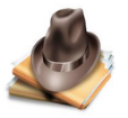In-between Representational & Abstract Imagery

Representational art or figurative art , references objects, or events in the real world. Romanticism, Impressionism, and Expressionism contributed to the emergence of abstract art in the nineteenth century. Even representational work is abstracted to some degree; entirely realistic art is elusive.
Abstract art … seeks to break away from traditional representation of physical objects. It explores the relationships of forms and colors, whereas more traditional art represents the world in recognizable images.
____________________________________________________________
My attempt to have one (artistic) foot in each world.

© A. Mac/A.G.

Come straddle the genres with me and feel free to comment positively or negatively.
I have been seeing ads on TV for a company that will transpose any photograph onto glass. This one would be awesome for that process.
Please explain what makes your example "representational" as opposted to "realistic". Is it the blanking out of the background? - the exteme underexposure of parts of the petals?
"Representational" actually refers to the portrayal of "content," that is, subject matter that maintains enough recognizable attributes so as to be identifiable to the viewer. "Representational" and "Realistic" are often used interchangeably.
As 'artistic license" allows for the rearranging, partial or total transformation and/or uncharacteristic points-of-view, or, "content-free"* graphic art works, it thus moves from "representational" to "abstraction" or "expressionism."
Had I increased the transparency of the Hollyhock flower so that it faded into the background, or, i.e. blurred the edges to "melt" into it, or had I made it unrecognizable as anything other than color and form … with no clue as to function, it would have thus, by definition (in Art), become "abstract".
* The well-know abstract expressionist painter, Jackson Pollock, was admonished from time-to-time, for getting away from his famous painting style and moving toward "content"!
By Jackson Pollock
My Hollyhock Flower "Abstract"
I think your Hollyhock flower is way more representational than abstract. Although in your explanation you make it more abstract, I see little to call it abstract in the original article photo.
Although it's clear that your original photo is meant to only "touch" on being abstract, the example I provided in the most recent Friday/Saturday article is truly abstract, when compared to a realistic/representational original.
Correction, my examples were posted in your "Late Night" article, not the Friday/Saturday one.
Hence my headline “in between” ... a possible unanswerable question is “at what brush strike/digital edit, does a work cross the line separating representational from abstract?”
I think, that for the direction from representational to abstract, the point on the extent of the edit where an image that was recognizable becomes unrecognizable, or else so amorphous as to become ambiguous.
You asked a question. Do you have any comment about my answer?
Still no reply.
There is no one, definitive way to predict at what point a given brush stroke or edit transforms a representational work into an abstraction. It's quite subjective; consider Turner … several of his paintings appear to have elements of both representational, distinguishable content … and pure brush stoked paint.
Oops! Didn't see your reply until now. So since it's entirely subjective, there is no exact answer to the question.
Correct! Much of "abstract" art is poly-referential in that it evokes different reactions to different viewers.
Interesting discussion. I like abstract art as long as it doesn't go overboard.
"Overboard" is an interesting way to describe works of artists like Franz Kline, Pollock, Gorky, John Marin and others.
Then there's Joseph Stella …and Rothko.
Check them out and let me know if they fit "overboard"!